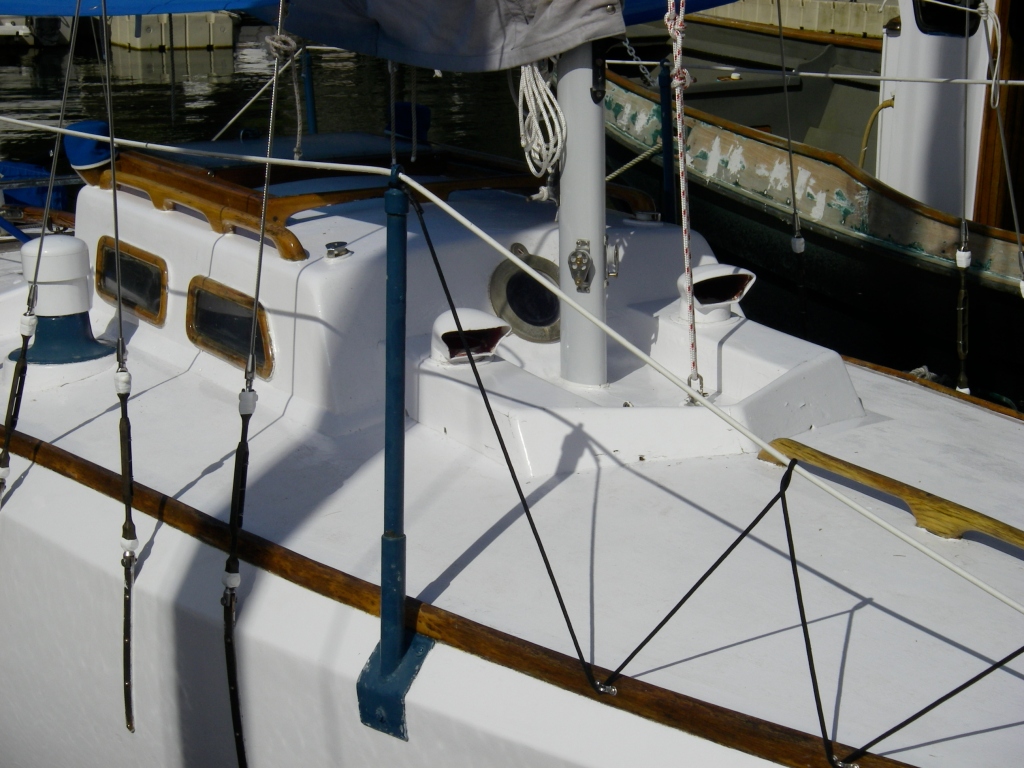 |
| TERN, July 2010 |
TERN was built by a fellow named Scott Schmidt in the late 1970's. He dreamt of building his noble craft and taking her offshore, and put incredible energy and love into the boat. He began construction in Lisbon Oregon, after acquiring the plans from Laurent Giles' firm in England. While Trekka was built with Western Red Cedar, Scott had found a beautiful supply of Port Orford Cedar (a type of yellow cedar), which had been cherry-picked for boat building because of it's straight grain. This is a superior material for strength and rot/insect resistance. Scott followed the plans to a "t" and, after completion, he lived aboard and sailed the waters between Seattle and North Vancouver Island. From there, his life changed and he sold the boat to someone who sailed her up to Alaska and back. Years later, the boat changed hands again and a Swiss man named Louis took stewardship of her for the next 15 years.
 |
| Phoca at anchor |
I first saw the boat when my girlfriend (now wife) and I arrived in the Pacific Northwest after completing a N. Pacific voyage on our Atkin-designed ketch, PHOCA. Our journey took us from Bellingham, to Southern California, Mexico, Hawaii and back, and we learned a lot about offshore sailing, what works as far as interior layout, equipment and sail inventory. Anyway, I spotted this lovely sloop at the marina we had arrived at, and went to have a look while we dried our sails. Immediately I recognized the design as very similar to Trekka, but with a sloop rig instead of yawl. The boat appealed to me in its simplicity and ruggedness, and had a distinct look which I liked. Other aspects of the design were almost identical.
A few years went by during which we sold our ketch "Phoca", bought some land, and created a simple, beautiful homestead. As life got more comfortable on our property, and the list of projects shrank to a fraction of what it had been for years, I again heard the siren call of another boat, and sailing.
I found out who owned the sloop (then called Dragonfly) and gave him a call. Louis met me at the boat and I got to see belowdecks for the first time. It was like a wooden gem inside. As I looked at the way things had been designed, built and maintained, I knew that this was a vessel I wanted to sail and own, and put my own energy into. A deal was struck, and I took ownership of her.
Since then, I have sailed the boat a lot, and have made many upgrades and improvements to ready her for the true ocean. I also re-named her "TERN". I just couldn't accept having a boat named for an insect out on the ocean. Usually, when you see insects on the ocean, they are like shipwrecked sailors; lost and barely surviving. A creature like a tern felt much more appropriate-light, buoyant and very much at home on the sea.
The designer, Laurent Giles, is renowned for his beautiful and distinct designs, and the story of how the design came to be is na interesting one. Essentially, he was hired to help an ambitious (and brave) small-boat sailor, Patrick Ellam, prove a controversial point; that it is possible to sail offshore in small, well designed craft, and that in some cases, they can be more safe and seaworthy than larger, heavier vessels. Laurent Giles listened to what Patrick's requirements and ideas were, and came up with "Sopranino". Sopranino was then sailed often and hard by Patrick and anyone else he could find to be crew. Eventually, to prove his point, he decided to sail her across the Atlantic, and did so with Colin Maude in 1951. They co-authored a book about their trip--"Sopranino".
 |
| Minim--sistership to Sopranino |
From feedback on the design after their 10,000 mile voyage, some minor yet significant changes were made resulting in the Columbia-Class, which is what Laurent designed for John Guzzwell's requirments in yacht: affordable (small), easy to built (small, and simply-designed), able to carry enough stores for ocean crossings (lot's of volume in the ends), no engine (able, nimble boat). She became Trekka, and John sailed her around the world, writing a book about it. The boat changed hands a few times and was sailed around the world again.
 |
| John Guzzwell's Trekka |















